Kill Screen Magazine's Blog, page 246
July 31, 2015
Gotham City Burning
Why no one but Batman cares about the city of Gotham.
What do you get when you combine Her Story with an owl? Hoot Story
I'm the owl guy. When my webcam pops on during Google Talk or Skype chats what you'll see is a miniature china owl looking over my shoulder from atop the fireplace. It does not hoot but sometimes I hear it. Directly behind me, at the other end of the room, is a cushion with an owl embroidered onto it sat on my brown sofa. And what sometimes sticks to the bottom of my mug o' tea? A coaster with two little owls on them.
If you start talking to me about owls I will tell you facts about them: 1) they have cloaca (they shit, piss, and have sex in the same hole), 2) they fly almost silently due to their unique serrated wing feathers, 3) a group of owls is called a "parliament." If we are near a computer, you will also be treated to a series of owl videos. You will have to watch Travis absolutely rockin' it, and an absurdly cute Northern saw-whet enjoying a stroke, and let's not forget the video of Tokyo's owl cafe. All of these are important and essential viewing.
"swap a videogame title with an owl-related word."
As a result of all this, I have a strigine wish that rarely comes true. And that is for more owl videogames. It's slim pickings right now. You've got the Legend of the Guardians videogame which is, well, the less said about that the better. More noteworthy is Kaepora Gaebora from the Zelda series, who is a magnificent and respectable owl, and one rumored to be the reincarnation of an ancient sage. Also repping the good videogame owl side of things is Icarus Proudbottom, who is a little bit cheeky but also a teacher to go along with it, meaning his sharp wit is acceptable for he is also wise. Oh, and the unreleased Owlboy is obviously high up on that list.
Of course, being both a fan of owls and videogames, I have entertained myself and my pathetic dream by combining the two in a daring game of "swap a videogame title with an owl-related word." It's a classic. Let me just crack my knuckles.... okay. Are you ready (you better be because they're terrible)? Fallowl 3. Hootline Miami. Life Is Strigine. Splatowl. Hoot of Duty. The Talon Principle. If you can come up with one for "tawny" I'll be in your debt.
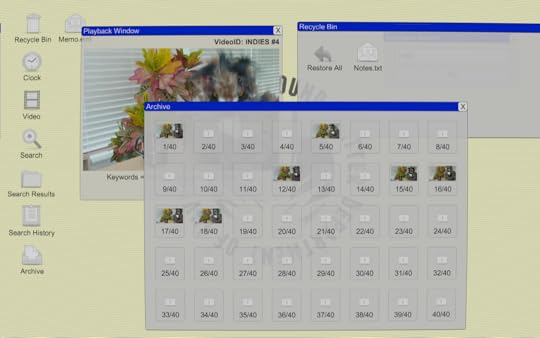
That was awful. But one that I missed out was Hoot Story. Yes, it's Sam Barlow's FMV crime fiction game Her Story, but it stars an owl instead of a widow. Brilliant, huh? I didn't come up with it. All credit should go to The Wise Old Games Owl who, it turns out, stars in the game, which was made in 24 hours and is "based solely on misremembered information from reading a single review of [Her Story]." As that is the case, Hoot Story is significant merely due to starring an owl, at least in my eyes. Unfortunately, it isn't a brilliant detective fiction about an owl that murdered a mouse trying to get away with it, or something along those lines. Nah, it's not that at all. I wish it was.
a hand shoved up his cloaca
Instead, the clips that you search for in its '95-style database are part of a grouchy and sarcastic rant about the videogame industry and its caustic monoculture. The owl is there to represent "wise" game creators with decades of experience who are, in fact, probably a little outdated and perhaps gross in their self-assured views. The owl speaks about Peter Molyneux and his many lies, GamerGate and the hopeless "indie" struggle, strip clubs and cocaine. Yes, the owl is shown to be a negative figure (he does have a hand shoved up his cloaca) and this saddens me. This is not the owl game I asked for.
But it is a game starring an owl, nonetheless. And it does have some fair points to make that aren't related to owls at all. Plus, it is an amusing spin on Her Story for at least a few seconds. We are allowed that, aren't we—a little humor? Yes, I think so. Now bring me more owl videogames. My talons itch for them.
India���s new political app is Tinder with a point system
Indian Prime Minister Narendra Modi has shown himself to be a digital revolutionary for his country. He has 14 million followers on Twitter, 29 million likes on his Facebook page, and trails only behind President Obama for the highest number of online fans for a national leader. Earlier this month, he revitalized his campaign to provide fast internet connections to 250,000 Indian villages by 2019, after arranging for free wi-fi at the Taj Mahal. In India, one of the fastest growing technological platforms in the world, Modi has established himself as a social media icon.
The only thing he was missing was an app.

Modi’s app, aptly titled “Narendra Modi,” is the official mobile platform of the Indian Prime Minister. With it, you can chip in on polls about your favorite laws and ordinances, read about the latest government mandates, and write letters to the prime minister himself.
"like Tinder … for good governance”
Another feature is to show your approval of various government actions, by swiping left or right. “It is like Tinder … for good governance,” says an app review from the BBC. “Except all you can do is approve, and share your approval.”
For approving government policies, and then sharing your approval on social media, the app rewards you with points, like a form of weird propagandic gamification. For your points, you get badges. "Earn them all and establish yourself as a true changemaker," the app says. So swipe right, people of India, and enjoy the warm fuzzy feeling inside knowing you got involved with your government.
The app is available for free on Google Play.
Life is Strange Episode Four: It���s Almost Over, Baby Blue
A videogame series blooming into early adulthood.
July 30, 2015
Following the digital ghosts of a dead social network
Do you worship at the altar of the microblog?
Think about it. What’s your morning ritual? Reaching for your phone before you brush your teeth? Commenting on a Facebook status during the drive to work? Replying to emails between bites of a breakfast bagel? The trailer of Book of the Dead says it best: “Entertainment dominates our lives. We consume content and it consumes us.”
We consume content and it consumes us.
Silverstring Media, the team behind Book of the Dead, calls the project a digital triptych, a three-part interactive project, on a world in ruins after the collapse of a social network. The first part of the project, “The Viral Dusty Dead Identity Quiz,” is described as “an examination of content marketing and social virality in the context of a fictional franchise,” and is set for release on August 4.
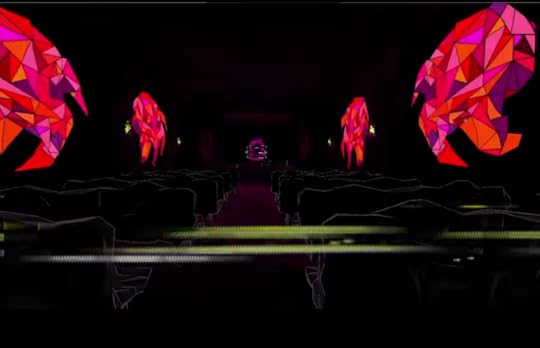
You might remember Silverstring Media as the team behind Glitchhikers, the introspective simulation of a nighttime drive where you pick up hitchhikers and have elliptical conversations. Book of the Dead seems to follow in its aesthetic footsteps, capturing much of the same vividly melancholy atmosphere. Visual elements pop out in crimson or fluorescent purple against a grayscale spacey backdrop. The trailer spares only small glimpses: white eyes and a red skeleton, pink stained-glass windows in what seems to be a black church for the dark gods of social media.
Silverstring Media originally conceived Book of the Dead as “an occult exploration of a dead website,” but altered the game’s focus after being harassed online. "We started designing the concept for Book of the Dead a year ago," Silverstring designer Claris Cyarron states, "and then GamerGate hit. We—a tiny studio—were inexplicably pegged as shadowy corporate overlords pulling the strings of all gaming journalism. Even so, we escaped the worst of it. Always a double-edged sword, social media took on a more directly sinister aspect as we watched our friends and colleagues get harassed out of the industry and their homes. Book of the Dead's design had to adapt to reflect this recent history and, for many, new reality."
After the arrival of “The Viral Dusty Dead Identity Quiz” next week, look out for part two, “Ruinbook,” a look at what’s left behind of a social network after its demise, and the final installment, “Book of the Dead,” an exploration of those ruins come to life.
You can keep up with the news on Book of the Dead here.
Whateverland brings explorable art to personal VR
Designers at Lucid Trips have announced Whateverland, a game world that is also a virtual reality art gallery, allowing players to explore on personal VR devices. Players will be able to propel themselves as a pair of dissociated arms through a colorful “Dreamplanet” and interact with pieces that can be later bought in the form of a 3D print. The gallery will feature the work of prominent German artists Gero Doll, Rolf Bergmeier, Neo Rauch, and Daim.
a more immersive “flying” experience.
The designers hope to make their project cross-platform—inclusive of Oculus Touch, HTC Vive & Lighthouse, and Sony's Project Morpheus—using dual hand controllers. They aim to make control intuitive and simple; players simply push themselves off the ground, and this mechanic allows for actions as diverse as swimming, walking, and flying. Though their world can be explored sitting or standing, Lucid Trips also includes a rig and hanger for players to suspend themselves from the ceiling and a device to simulate airflow—that is, drag and drift—to create a more immersive “flying” experience.
Whateverland is only the first planet in what they hope to eventually be a diverse “solar system” of Dreamplanets, eventually including user-created content.
Back to Bed's creators on bringing surrealist architecture to videogames
From the melting clock to the overgrown green apples, the paint-chipped fingerprints of René Magritte and the flamboyant moustache of Salvador Dali are all over the topsy-turvy dreamscapes of Back to Bed. This puzzle game about escorting a somnambulist named Bob back to his duvet using the physical manifestation of his subconscious—a green dog-like creature called SuBob—is essentially every famous surrealist painting mashed together and made virtual.
The other recognizable influence are the conceptual drawings of impossible structures by noted graphic artist M. C. Escher. These aren't necessarily recreated in Back to Bed as the surrealists' works are, but are alluded to through distorted staircases that head off in directions opposed to gravity, and blocks of architecture that seem to be simultaneously above, below, and adjacent to each other.
the special atmosphere his works create.
Bedtime Digital, the team behind Back to Bed, talked to us about its fascination with surrealism and Escher's architecture. This was done in advance of the game arriving on PlayStation 4 and PlayStation Vita this August. But we were also able to briefly touch on how Bedtime Digital is looking to expand upon the ideas within Back to Bed with its next game Dream Factory. Read the Q&A below for the details.
KS: Back to Bed started as a student game. How has it changed and been added to since that initial idea up until these new PlayStation versions?
So, actually, instead of continuing to build more levels and adding features to the game, we decided to start over with the level design. Take what we learned from the student version and then handcraft all new levels that were not only beautiful to look at but also challenging and fun to play. On top of that, we've created a whole new "world" with new unique visuals that are even more surreal.
We also focused on making the game more accessible and not too punishing to the player. But we also added a hardcore "Nightmare" mode that you unlock when you beat the first 30 levels that tests the skills of even the most hardcore puzzle gamers. You want a game to be easy to learn but still hard to master, right?
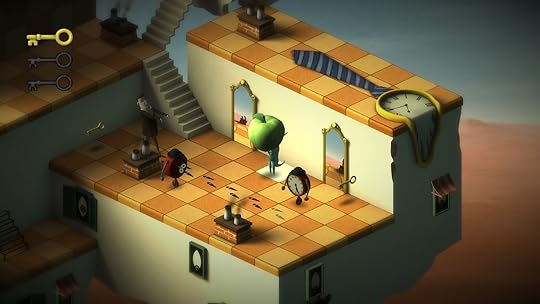
KS: You say that you were inspired by M.C. Escher. Was it his impossible structures specifically and, if so, what about them grabbed you?
It was partly the impossible structures that he is so famously known for but also the special atmosphere his works create. It can almost seem a little creepy at times, but still too intriguing to take your eyes off of it.
KS: Did you struggle at all to recreate the twisted logic of Escher's structures - any particularly challenging moments you can remember? And do you feel that you were successful in adapting his ideas to a 3D puzzler?
We feel that the spirit of M.C Escher carries over well in our game, and his twisted logic or "Dream Logic" as we call it, has contributed a lot to the game. The impossible structures idea was a challenge at first, but once you learn a few camera tricks, it's actually fairly easy to pull off. The real challenge is getting actual gameplay out of the "dream logic" such as shifting gravity to walk on walls.
the idea of having the game world look like a dream
KS: Surrealist artists such as Salvador Dali and René Magritte also factor into Back to Bed. What did you take from these two artists and why did you feel surrealism was a good match for Back to Bed?
The game mechanics of guiding a sleepwalker came first, and then our art director came up with the idea of having the game world look like a dream, which is what surrealism is all about so that was a great match. It's really something that makes Back to Bed stand out and it’s often what draws people in at first when we showcase the game at events like E3 and Gamescom.
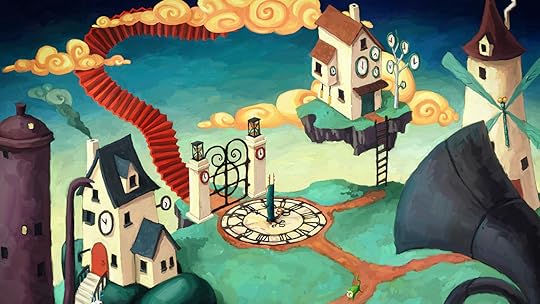
KS: You're continuing to explore the same type of surreal architecture in your next game Dream Factory. What's your fascination in creating these environments - what does it satisfy for you?
We kept hearing from people that played the game that they loved it. But they really wanted more time to go and explore this surreal crazy world. So, naturally, we wanted to give people this chance to do this in our next game.
KS: What have you learned from Back to Bed about creating these types of landscapes that have informed Dream Factory? What are the big differences in the structures you've made for Dream Factory when compared to Back to Bed?
I guess you could say that our next title takes a step deeper in to the world of dreams. You will still find small references to surrealism throughout the game, but we rely much less on inspiration from other peoples work this times around, and we try to create a world of our own that is cohesive and self-contained.
Back to Bed will be out for PlayStation 4 and PlayStation Vita in mid-August. More information on Dream Factory can be found on its website.
Pneuma has things to say. Don���t listen to them.
I babble, therefore I am
July 29, 2015
Soccer City's ironic realism does away with pesky player agency
“Football is a simple game,” the onetime England striker and fulltime milquetoast TV personality Gary Lineker once explained. “Twenty-two men chase a ball for 90 minutes and at the end, the Germans always win.” Alternately, football is an incredibly complicated tactical exercise at the end of which the Germans admittedly tend to win. Soccer City, a strategy boardgame about the beautiful game that is currently raising funds on Kickstarter, veers towards that latter view of the sport.

Soccer City bills itself as “the most realistic football board game ever made,” which is big talk from a game with soccer in its title. Then again, it’s hard to think of a more eligible candidate of that title. Even though much of Soccer City’s turn-of-the-century presentation has the ironic tone of the excellent Twitter parody account @ArsenalGent, it may be on to something here.
treats soccer as a more sophisticated form of chess
Two years after the release of a Spanish-language edition, Soccer City’s English release will invite players to engage in turn-based gameplay on a board made up of hexagons. Those hexagons match the shape of the pedestals on which twenty-two plastic statuettes—crosses between Subboteo tabletop football figurines and toy soldiers—sit. The player on offense goes first, picking one of the cards in her hand that corresponds with an action. The defensive player follows suit. Back-and-forth they go. With 165 cards, additional external factor cards, tactical sheets listing defensive and attacking actions, and a referee’s dice that can be used to mete out disciplinary actions, Soccer City offers plenty of options. You can dribble and weave your way through traffic, overcome challenges, shoot, and potentially score.
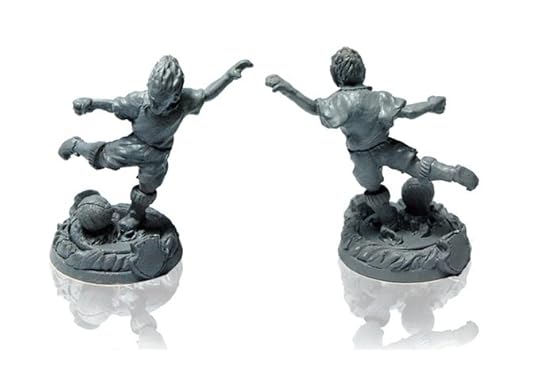
Football, of course, is not a turn-based sport. The beautiful game’s, er, beauty is most apparent in those moments when hundreds of little moments and factors come together just right. But that is a difficult phenomenon to reproduce in a game, particularly one with a board. Moreover, all these contingencies and interacting forms of agency are not universally adored. They have not always existed, at least not in the ways they now do.
Soccer City’s mechanics can be thought of as a throwback to the days before players couldn’t force their way out of contracts or have their contracts expire, when the freedom of great players to ‘express themselves on the pitch’ wasn’t widely accepted as a philosophical goal, and the manager’s role was somewhere between that of a puppet master and taskmaster. In that respect, Soccer City’s turn-based design matches its retro artistic vision. The game treats soccer as a more sophisticated form of chess, which is both an intriguing idea and a way to reintroduce the primacy of the manager over his pawn-like players.
Meet the VHS tape monsters of our wasteful future
French artist Philip Ob Rey's latest project pitches sculptures "skeletonned with VHS film-rolls" against the grey skies of Iceland. His series of black-and-white photos and accompanying short films share haunting visions of a post-human world. It's one in which primordial giants have arisen, tangled in the tape reels that remain of our lost culture, stumbling menacingly across a cold wasteland.
the unnatural waste of electronics that we leave behind
"V" HS Project, as Ob Rey calls it, comprises five series of photos: "The Lavas' Whisper," "Submarine Wings and Seeds," "Thousands of Njord's Feathers," "Shadows of Bedrock Children," and "Unknown Ashes - Unknown Voices." Each of these capture a different nightmarish figure in the throes of its new-found existence. Despair and terror are found in their faceless forms, but the influence of Parisian haute couture (which Ob Rey grew up around) is visible in the trailing black ribbons, resembling gowns and elaborate head pieces.

The shadowy bodies of the creatures were also fettered with stones, shells, feathers, and dry seaweed picked from the surrounding hulking mountains and ice-cold Icelandic beaches. It's a marriage of materials that alludes to the visual and thematic focus of the entire project. "I built creatures made of VHS, covered with a black toxic skin, a chaotic flesh of magnetic encoded images, dreamlike and disfigured in reaction against the growing dictatorship of mass media and the unstoppable plastic pollution due to the overconsumption of new technologies," Ob Rey told Huffington Post.
The idea is to convey eerie sculptures that have formed from the unnatural waste of electronics that we leave behind in our constant race towards technological advancement. What happens to all the obsolete material we leave behind? A lot of it gets churned up and dumped into a swelling black lake of toxic sludge in Mongolia, which itself is foregrounded by chimneys puffing poisonous smoke into a charcoal sky.
This lake is a real part of the landscape on Earth right now and it has resulted purely from our obsession with consumer electronics. With that in mind, Ob Rey's stark visions of a future wasteland inhabited only by VHS monsters doesn't seem so wildly fictional after all.
You can see "V" HS Project in its entirety on Ob Rey's website.


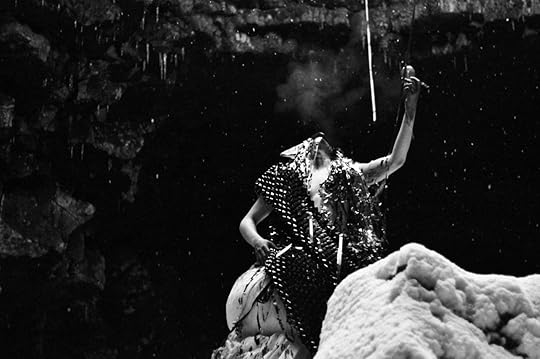


Kill Screen Magazine's Blog
- Kill Screen Magazine's profile
- 4 followers



